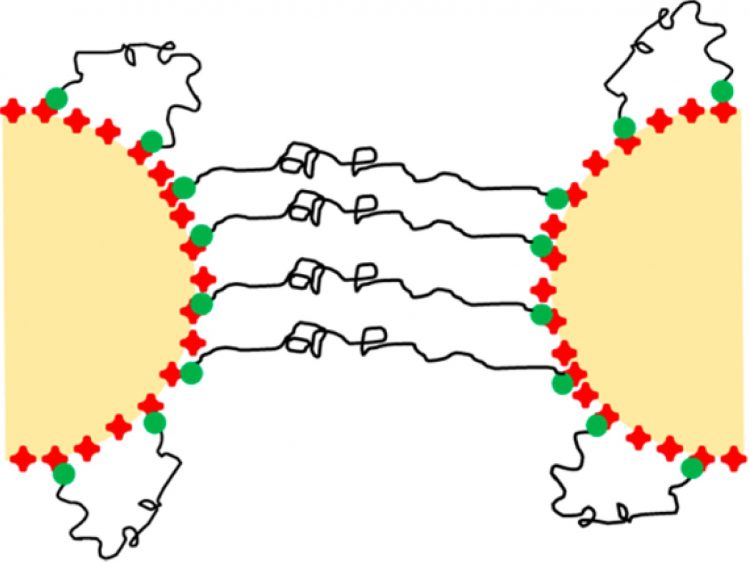Seeing is bead-lieving

DNA linkers serve as bridges between colloidal beads in a new experiment by Rice University scientists to study the physics of “bead-spring” polymer chains. They found the chains can be tuned for varying degrees of stiffness or flexibility. (Credit: Biswal Lab/Rice University)
Rice University researchers are using magnetic beads and DNA “springs” to create chains of varying flexibility that can be used as microscale models for polymer macromolecules.
The experiment is visual proof that “bead-spring” polymers, introduced as theory in the 1950s, can be made as stiff or as flexible as required and should be of interest to materials scientists who study the basic physics of polymers.
The work led by Rice chemical and biomolecular engineer Sibani Lisa Biswal and graduate student Julie Byrom was published this month in the American Chemical Society journal Langmuir. The researchers found the best way to study the theory was to assemble chains of micron-sized colloidal beads with nanoscale DNA springs of various lengths.
“Polymers are classically described as beads connected with springs,” Biswal said. “A lot of polymer physicists have come up with scaling laws and intuitive polymer properties based on this very simple concept. But there are very few bead-spring model systems that you can actually visualize.
That’s why this work came about.” Microscopic solids suspended in a liquid like the fat particles in milk or pigment particles in paint are examples of a colloidal system. Biswal said there has been great interest in creating colloidal molecules, and the Rice experiment is a step in that direction.
To make complex colloidal macromolecules, the researchers started with commercially available, iron-rich polystyrene beads coated with a protein, streptavidin. The beads are charged to repel each other but can connect together with springy DNA fragments. The chains formed when the researchers exposed the beads to a magnetic field. “We use the field to control particle positioning, let the DNA link the beads together and turn the field off,” Biswal said, explaining how the chains self-assemble.
“This is a nice system for polymers, because it’s large enough to visualize individual beads and positioning, but it’s small enough that thermal (Brownian) forces still dictate the chain’s motion.” As expected, when they made chains with short (about 500 base pairs) DNA bridges, the macromolecule remained stiff. Longer linkers (up to 8,000 base pairs) appeared to coil up between the beads, allowing for movement in the chain. Surprisingly, when the researchers reapplied the magnetic field to stretch the long links, they once again became rigid.
“Our vision of what’s happening is that DNA allows some wiggle room between particles and gives the chain elasticity,” Biswal said. “But if the particles are pulled far enough apart, you stress the bridge quite a bit and reduce the freedom it has to move.” Being able to engineer such a wide range of flexibilities allows for more complex materials that can be actuated with magnetic fields, Biswal said. “This research is interesting because until now, people haven’t been able to make flexible chains like this,” Byrom said.
“We want to be able to explain what’s happening across a broad range of polymers, but if you can only make rigid chains, it sort of limits what you can talk about.” Now that they can create polymer chains with predictable behavior, the researchers plan to study how the chains react to shifting magnetic fields over time, as well as how the chains behave in fluid flows. The paper’s co-authors are Rice alum Patric Han and undergraduate Michael Savory. The National Science Foundation supported the research.
Media Contact
More Information:
http://news.rice.edu/2014/07/28/seeing-is-bead-lieving/All latest news from the category: Materials Sciences
Materials management deals with the research, development, manufacturing and processing of raw and industrial materials. Key aspects here are biological and medical issues, which play an increasingly important role in this field.
innovations-report offers in-depth articles related to the development and application of materials and the structure and properties of new materials.
Newest articles

Properties of new materials for microchips
… can now be measured well. Reseachers of Delft University of Technology demonstrated measuring performance properties of ultrathin silicon membranes. Making ever smaller and more powerful chips requires new ultrathin…

Floating solar’s potential
… to support sustainable development by addressing climate, water, and energy goals holistically. A new study published this week in Nature Energy raises the potential for floating solar photovoltaics (FPV)…

Skyrmions move at record speeds
… a step towards the computing of the future. An international research team led by scientists from the CNRS1 has discovered that the magnetic nanobubbles2 known as skyrmions can be…





















